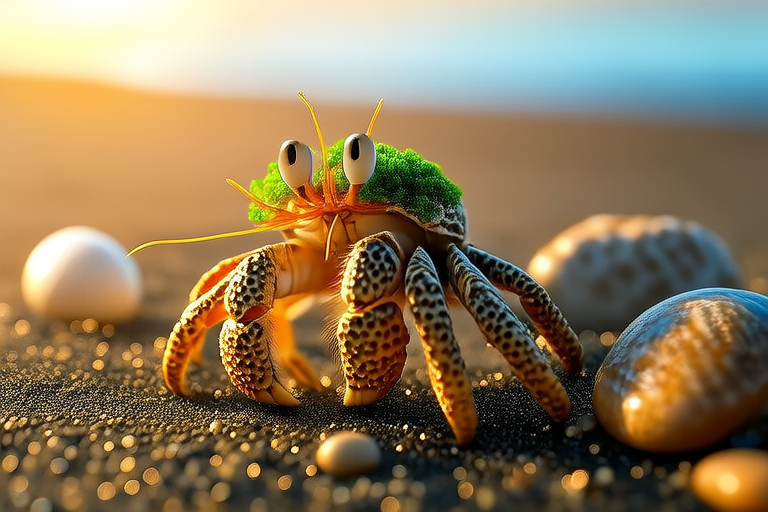Adorable Photos of Hermit Crabs That Will Melt Your Heart
Welcome to a delightful journey through the charming world of hermit crabs! These tiny creatures, with their whimsical personalities and endearing quirks, have captured the hearts of many. From their unique shell choices to their fascinating behaviors, hermit crabs offer endless fascination. This article will take you on a visual tour of some of the most adorable hermit crab photos, accompanied by fun facts that will deepen your appreciation for these delightful crustaceans.
A Journey Through Their Shells
Hermit crabs are perhaps best known for their unique shells. Unlike other crustaceans, hermit crabs cannot produce their own exoskeletons. Instead, they rely on the discarded shells of other sea creatures to protect their soft bodies. This dependency on secondhand homes has given rise to one of nature’s most adorable scavenging habits.

Take a look at this photo: our little friend is peeking out of its spiral shell, its tiny antennae twitching curiously. Each shell chosen by a hermit crab tells a story. Some crabs prefer the classic elegance of a conch shell, while others opt for the quirky charm of a whelk or even a small snail shell. It’s like a fashion show under the sea, where every crab showcases its personal style.
The Social Lives of Hermit Crabs
Hermit crabs are social animals, often living in large colonies. They can be found scuttling together along the seashore or gathering in shallow tide pools. Their communal nature makes them particularly interesting subjects for photography.

This photograph captures a group of hermit crabs gathered together on the beach, their shells creating a patchwork of colors and patterns. It’s easy to see why they are sometimes called ‘land hermits.’ Despite their solitary appearance, they are quite sociable when it comes to finding new homes or exploring their environment. They even communicate with each other through a series of chirps and clicks, which they make by rubbing their legs together.
Hermit Crab Behavior: A Closer Look
Hermit crabs are not just passive dwellers; they are active explorers. When they find a new shell, they don’t just move in without inspection. Instead, they carefully examine it, testing its fit and strength before making a decision. Sometimes, they even engage in what appears to be a shell swap dance with other crabs.

In this photo, we see a hermit crab inspecting a potential new home. Its small claws are busy feeling the surface, ensuring it’s the right fit. It’s a delicate process, and it’s fascinating to watch. Once satisfied, the crab will quickly move into its new home, ready to explore further.
Fun Facts About Hermit Crabs
Hermit crabs are full of surprises. Did you know that they can live for up to 30 years? Or that they are one of the few animals that can change their body shape to fit their surroundings? Here are a few more fun facts:
- They are not true crabs: Despite their name, hermit crabs are not true crabs. They belong to a different family of crustaceans called Anomura.
- They can regenerate lost limbs: If a hermit crab loses a limb, it can grow a new one over time. This ability is especially useful when escaping from predators.
- They are nocturnal: Most hermit crabs are active at night, making them harder to spot during the day.
- They have gills but can breathe air: Hermit crabs have gills, but they can also breathe air. This adaptation allows them to live both in water and on land.
The Appeal of Hermit Crabs as Pets
Hermit crabs have become popular pets due to their low maintenance and unique appearance. Many people enjoy watching their hermit crabs interact with their environments, especially when it comes to changing shells. However, it’s important to remember that hermit crabs require specific care to thrive in captivity.

This photo shows a hermit crab climbing up a small tree branch in its terrarium. It’s a perfect example of how these crabs can add a touch of the wild to any home. When kept as pets, hermit crabs need a habitat that mimics their natural environment, including a shallow water dish, a sandy substrate, and plenty of climbing structures. Providing a variety of shells is also essential, as it allows them to choose the one that suits them best.
Conservation Efforts for Hermit Crabs
While hermit crabs are not currently endangered, their habitats are under threat due to climate change and pollution. As stewards of the planet, it’s important for us to support conservation efforts that protect these fascinating creatures.

This photo captures a hermit crab in its natural habitat, blending seamlessly with the environment. By supporting organizations dedicated to marine conservation, we can help ensure that future generations will have the opportunity to appreciate the beauty and uniqueness of hermit crabs.
Conclusion
Hermit crabs are truly adorable creatures, and their unique lifestyle and behaviors make them endlessly fascinating. Whether you’re drawn to their charming shell choices, their social interactions, or their quirky personalities, there’s no denying that hermit crabs have a special place in our hearts. We hope this article has inspired you to learn more about these delightful crustaceans and perhaps even consider adopting one as a pet. Remember, every little step we take to protect their habitats helps ensure their survival for years to come.
